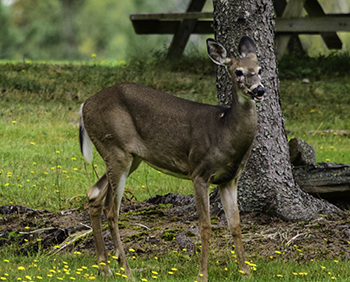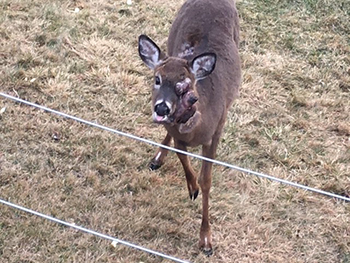Home → Fish & Wildlife → Wildlife → Living with Wildlife → Wildlife Diseases → Deer Fibroma
Deer Fibroma

What is deer fibroma?
Also referred to as cutaneous fibromas, fibromas, fibromatosis, or deer warts.
Deer fibromas are wart-like growths on deer that are typically caused by an infection with a species-specific papillomavirus. These manifest as firm, warty growths fixed to the skin of a deer. They vary in size (though most are just a few centimeters in diameter), are typically dark in color and bare of fur, and often appear fissured or lumpy. They may be found throughout a deer’s hide, but are most commonly seen around the eyes, face, and neck. Most infected deer have just a small number of small fibromas, but cases of large fibromas and fibromas widespread about the hide are not uncommon.
Where have deer fibromas been found?
Deer fibromas are common and occur throughout the range of white-tailed deer in North America. Other similar fibroma diseases exist in other species such as squirrels and rabbits.

Can deer fibromas be treated?
There is no effective and broadly applicable treatment for deer fibromas. In captive animals, it may be possible to surgically remove large growths, but this is not a practical treatment for wild animals. Wildlife rehabilitators may provide care for and encourage the health of deer that are negatively impacted, but in most cases, impacted deer should be left alone in the wild. In severe cases where a deer is unable to eat, see, or move normally, euthanasia may be the most appropriate course of action.
What is the impact on deer and the population?
In most cases, fibromas will not negatively impact the health of infected deer, and fibromas are not known to be a significant source of deer mortality. These fleshy growths impact only the skin of the animal. In severe cases, fibromas around the eyes or mouth may impact a deer’s ability to see and to eat, and very large fibromas throughout the body may impede movement.
Can fibromas spread to humans, pets, or livestock?
The virus that causes deer fibromas is not known to infect humans. Fibromas are caused by a papillomavirus, which are species specific. Though similar diseases exist in other species, deer will not spread their fibromas to pets, livestock, or other species.
What can I do?
In most cases, deer with fibromas can live a normal and productive life and should be left alone and allowed to do so. In severe cases where abnormally large or unfortunately placed fibromas are negatively impacting the health of the deer, you are encouraged to contact your local regional office of MDIFW to report the case and consult with a biologist.
Hunters that harvest a deer with fibromas should skin the animal out and treat the carcass and meat as they would any other deer.